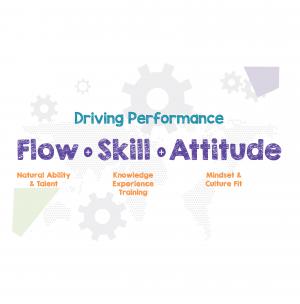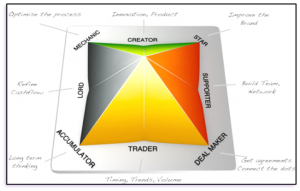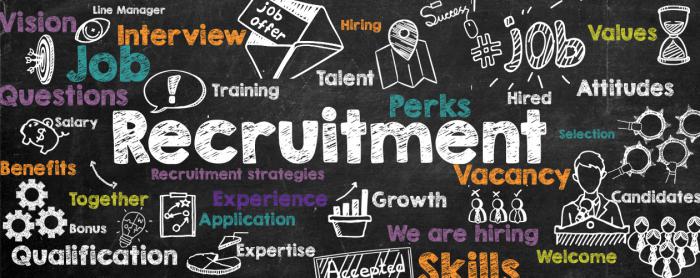Recruiting good people is one of the perennial problems for any ambitious owner managed businesses, it’s also critical to get right because of the implications it has.
And to deal with this subject one hit:
1) This blog might be a little longer than usual.
2) We’ll focus only on the recruitment and selection activities, not the marketing of the role activities.

Recruiting, and then holding on to, good A team players is really about getting three aspects of the recruitment process absolutely right:
- The applicant’s attitude, mindset and fit
- Their skill set, knowledge and experience
- Whether or not the job fits their temperament, whether they are in “flow” for the core activities undertaken
So what we are looking to create, and embed, is a recruitment and selection process where you can be 90% confident that the person you are recruiting can, and is willing to, do a mega hot job.
But recruitment is time consuming, expensive and usually critically important. There are major hurdles that need to be overcome.
The first of which is it is increasingly easy for an applicant to simply whack in a CV for a job they may only be partially be interested in. Employer gets overwhelmed and the best candidates fall through the net. You need to process that ensures the cream rises to the top
Creating a process of deselection
If we want the cream to rise to the top we need to make it easy for
- Those that don’t want the job to deselect themselves
- Those that really do want the job, to shine
In short, we need to create a process of deselection, through which there are a number of hurdles the candidate has to overcome. If they don’t overcome them, they don’t get to the next stage. They don’t make the cut. This way they do the work for you. But it does mean you have to be disciplined and you do have to hold your nerve .
Job descriptions v job scorecards
Clearly, as an employer, you need some benchmark against which to both recruit and to manage someone once in post. Additionally, the person applying is highly likely to want to know the types of things they are going to be required to undertake. In most instances this would be the job description; a description of the tasks to be undertaken and if we take a relatively generic job say financial controller it would include things like:
- processing invoices
- banking cheques … although this may obviously dwindle as cheques become less used
- paying suppliers
- providing reports
However, a job description is usually exactly that, a description of the tasks that need to be undertaken. These days we prefer a “job scorecard” which is similar but subtly and significantly different; scorecards seek to define the outcomes for the most critical components of the job. Depending on the job and the variety within it there is usually anywhere between 3 & 8 outcomes and each outcome may have one or more components to it. (See download example)
The key difference between the job description and the job score card is that for each outcome there is one or more key performance indicators (KPIs). Job descriptions focus on tasks, job scorecards focus on results.
Once the outcomes and KPIs have been established you need to take a step back and consider the three key issues:
- Attitude, mindset and fit
- Skill set, knowledge and experience
- Flow
However, I think we’d concede in some instances you need both the scorecard and the description, as for some rolls some of the activities that need to be undertaken are neither difficult nor worth scoring.
A key point here is the scorecard becomes the bedrock on which the whole of the recruitment and the management thereafter, process is built. And a typical scorecard might take three to four hours to construct from scratch. You might say “that’s a hell of a lot of my time” … but it’s a case of do you put the work in now and reap the rewards later or do you skimp now and pay the price later …As my coach Marco would say “It’s a challenge to get right, but the juice is worth the squeeze.”
… if you don’t get your scorecard right you are going to be building on fundamentally shaky foundations. If you don’t get the score card right you’ll get problem people and a whole world of pain.
Questions and the questionnaires
The freshly minted scorecard is now in place and we can now begin to think about the questions we are going to need to ask throughout the process to give us confidence that our candidates can, and will, do the job. Questions need to be developed such that you can confidently tease out the candidates attitude, mindset, fit, skills, knowledge, experience and preferred working style, their flow, in a way that ensures that they meet your expectations.
At this point it’s useful to consider that typically, 70% of a job is about attitude and only 30% the technical skills. In fact, at the top of every page of our recruitment processes, associated documentation and question sets we develop, we make that statement as a reminder, along with bullet points of the values and competences we are looking for.
Different questions will need to be asked at different stages and first hurdle is to ensure that the applicant has the skills to undertake the job, so we’d suggest:
- Telephone interviews focus on the skills, knowledge and experience
- Face to face interviews focus on the cultural fit – attitude and mindset
Skills, knowledge and experience are usually easier to determine and cultural fit is better explored in person.
We know you’re going to be inundated with CVs all variously presented and in most instances, they won’t have been adapted in a way that allows you to get to the heart of what you really need to know.
If you wade through this lot it’s you that’s doing the work.
Again it’s an investment but creating a questionnaire based on what you’re looking to establish with the candidate does a number of things:
- It ensures you get all of the information you need up front and in advance of investing significantly more time and effort. (It also only needs to be done once)
- It allows you to comprehensively and easily compare and contrast the different candidates
- It also allows the applicant to shine.
Using the three pillars of attitude, skills, and flow we ask a series of questions then ask the candidate to demonstrate their credentials against them. In addition, we ask people to score each question as to 1) their level of skill and 2) their level of enjoyment. We want people to enjoy what they do.
Oh, and the final question on the questionnaire should always be is there anything else you’d like to tell us?
The prep’ work is now done; we are now going into the process and the hurdles you need to construct.
First filter – use the tech’
Rightly or wrongly, we’re going to gloss over generating adverts and the marketing of the role and simply assume we now have a deluge of applicants.
Nearly all jobs are now advertised on job boards like Indeed, Reed, Monster and others.
Most of these allow you to add various tests to your selection process , but often they remain a stubbornly unused component that can easily be applied filter out half-hearted applicants. Activating these tests is the first hurdle in systematically separating those that really want the job from those that are simply hijacking your time. Remember, A team players are all those that are likely to really want the job, and if they really want the job, they’ll be eager to put the work in.
So always, always, always choose and use the most relevant tests and make absolutely sure that you only ever take to the next stage those that have completed them and are found to be proficient.
Don’t complete the tests. Don’t make the cut.
Second filter – the questionnaire
It’s now time to unleash the questionnaire, which will be sent with a strict deadline for completion, to ensure you get all of the information you need up front and in advance of investing significant time and effort.
So to summarise:
- They don’t return the questionnaire they don’t make the cut
- They don’t meet the deadline, they don’t make the cut
- They don’t score it properly (e.g. If everything is marked as a 10), they don’t make the cut
- They don’t put anything in the tell me more box, they don’t make the cut
No excuses. They have deselected themselves. Remember you are protecting your time.

Using the returned questionnaires, you now have and quick and easy way to make like for like comparisons between candidates. It is only once you’ve done that that you’ll want to review the CV’s from which you might create additional questions specific to each candidate.
Having made your selection to take to the next stage you send the commitment letter and arrange the telephone interview.
The 3rd filter – a commitment letter
This is a recent introduction of ours … There’s a great book, a very practical, very down to earth book on management called “The Road Less Stupid” written by a guy called Keith Cunningham. In it he describes a commitment letter he sends to all potential recruits detailing his expectations. We’ve taken this idea and applied it to our own and our clients’ recruitment processes. It really helps separate the wheat from the chaff. (See download example)
Essentially before taking on someone on board we’re asking them to make a series of commitments about the approach we want them to take should we take them on – it makes no bones, and lays out up front, the type of person that you’re asking for and the degree of commitment you are requiring of them.
This has two advantages 1) it will put people off that can’t make the commitment 2) At a later date should people not step up once on board you can use it as a reference point. If they are not ready to engage with the degree of commitment that you need… you don’t want them …They don’t make the cut.
The 4th filter – The telephone interview
The telephone interview is a very short 20 – 30 minutes screening interview designed to clear out the B & C players and focuses on making sure they have the relevant qualifications and skills …. It also asks four essential questions:
- What are your career goals …talented people know what they want
- What are you really good at professionally … We’d suggest you push for eight or more things so you can build a complete picture …it also pushes them
- What are you not good at or not interested in doing … results from here need to be cross referenced back to the scorecard and
- Who were your last five bosses and how would they rate you when we talk to them. Note the language – when we talk to them, the candidate will be thinking “ah-ha, I probably need to be honest”
This stage is really just to “head off at the pass” those candidates that, had they walked through the door … you know you would have had to spend an hour or more with.
If they pass the telephone interview it’s onto the psychometric
The 5th filter – The psychometric
I love psychometrics … Many years ago I was asked to complete my first psychometric test, I was about 24 at the time and I still remember the occupational psychologist that gave me my results. Her name was Helen and she said “Mark this is one of the most extreme profiles I’ve ever seen”, “Fantastic I thought!”…She then went on to explain that I was less questioning than 99% of the population, less detailed conscious than 99% of the population and more optimistic than 99% of the population. She went on to paint a picture where, metaphorically, somebody had dug a big hole, I’d fallen in it and was still as happy as a sandboy …all while somebody else was piling the brown smelly stuff on top of me. It was a proper wake-up call. I thought if that’s only half right I need to do something about it. (Incidentally, I still have a copy somewhere …I really ought to frame it!)
My first psychometric test brought me up sharp with:

1) What it knew about me
2) What little I knew about myself!
Since which time I’ve done a lot of work on myself … but I suspect the job ain’t finished!
The use of psychometrics is an adjunct to the interview process, it is often highly enlightening, but it needs to be undertaken before the main event so if it does throw up any “wobbly’s” you have a chance to probe at the interview.
So, if you are down to the last 3, 4 or even 6 people and a psychometric test costs you £50 for each one, I think, it’s an incredible investment to help you make the best decision you can and to ensure you find your A team player.
The tool we use is Talent Dynamics, there are others. We use talent dynamics as it focuses on establishing when someone is in “flow”. Its about not putting a square peg in a round hole. Someone may have all the skills, all the experience and have great personal attributes and have done the job previously and for years…but they are actually not in flow…they are constantly out of their comfort zone. Imagine being a big picture thinker and having to deal with detail all day long. Imagine being a real “people person” but having to deal with “processes and things” all day long. It can be done but you won’t be in flow and if you’re not in flow for a large chunk of time at work you’re unlikely to enjoy it.
At this point we’ve done a lot of work … and so has anyone getting this far …
The interview
In many organisations this is where the bulk of the recruitment work is done, but you’re smarter than that; by adopting the processes above you are well ahead of the game, by the time you get to this stage you should be 70 to 80% sure that person has the skills, knowledge and experience to undertake the job. At the interview stage the focus shifts to cultural fit, do your values align, do they have the same cultural fit?
Interview questions
For serious jobs always use a two-stage interview process, at the first interview pretty much the entire focus is on their previous work history and a very standard set of questions as shown below:
For each of your previous jobs can you talk us through the following questions?
- Why you took the job?
- What were you hired to do?
- What accomplishments are you most proud of? (and how you achieved them)
- Your low points, your mistakes and failures?
- What you liked most and least about the job?
- Name of supervisor, and that supervisor’s strengths and weaker points?
- What’s your best guess as to what that supervisor would say were your
- Strengths
- Weaker points and
- Overall performance?
- What were reason(s) you left that job?
The above questions should be printed on a single A4 page in large font so they’re easy to read and given to the candidate so they can work through them systematically . Alternatively, as is increasingly the case these days, if the interview is virtual we would tell the applicant they are going to get a set of questions 15 minutes ahead of the interview and ask them to print them. Working through questions for each and every one of their jobs shows:
- If they can follow instructions
- If they can follow a task through
- If they are structured in their thoughts
Sounds easy doesn’t it, just sit back and let them waffle on … Absolutely not! At this point you are the “can opener” your job is to dig deeper. Questions you might ask include:
- Can you tell more about that?
- Can you go into greater depth?
- What do you mean by that?
- Can you elaborate ..?
The key is to look for patterns …
- Where is the evidence of them going “above and beyond”?
- Where is the evidence of self-awareness?
- Where does the answer give away things about their culture, their approach… does it fit with yours?
- Are their “bad calls” always about a “bad boss” and/or “toxic relationships”?
- What do the answers say about how the applicant likes to be managed?
An interview like this for a run of the mill job should take at least 45 minutes perhaps an hour and for a senior role perhaps 2-3 hours. And notes should be taken to help you reflect and dig even deeper at the next interview.
Second interview
The second interview is your final chance to establish any shortcomings so at this point you need to review all of the information you now have available.
- The job board test results
- The returned questionnaire
- The CV
- Telephone interview notes
- Psychometric test results
- The face-to-face interview notes
The key question at this final stage is what else do you need to know to make 90% sure this hire who result in an A team player?
Conclusion
In the developing the above process we’ve created a framework where at a number of critical points only A team players will gravitate to the top, everyone else will deselect themselves by not making the cut. This approach has a number of significant advantages:
- You push back the heavy lifting to the applicant making the A team players rise to the top
- You create a consistent and easy to compare applicant to applicant process
- You significantly reduce your time in the process
- Most importantly, you get better quality of candidate
The objective here is to be 90% certain the person you are looking to recruit can, and will, do the job and will stay. Using the framework described above you get a mega hot process that if managed thoroughly and thoughtfully can give you that confidence.
Finally, one further thought to leave you with:
If there have been any doubts with any candidate at any part of the process and you are still considering them, as Jim Moon, my first ever consultant, who over the years knocked our recruitment process into a much better shape said “If in doubt don’t!” … Marco, my coach, would add “If the honeymoon is bad the marriage will be terrible!”.
All that remains now is to create a mega hot induction process but that’s a subject for a different day …
Related tools and ideas
Recommended references
Downloadable resources
- Briefing paper – How to Develop mission, vision, values and purpose statements
- The Values Inventory
- The Commitment Letter
- The Financial Controller Scorecard–
- The 1 page Recruitment Process
- Statius Information Sheet (SIS) Working On Your Business
To find out how Statius can help you deliver:
• Better strategies
• Better systems
• Better measurement and
• Engaged people delivering
• Better results
Call us now on 0208 460 3345 or email sales@statius.co.uk



Comments are closed